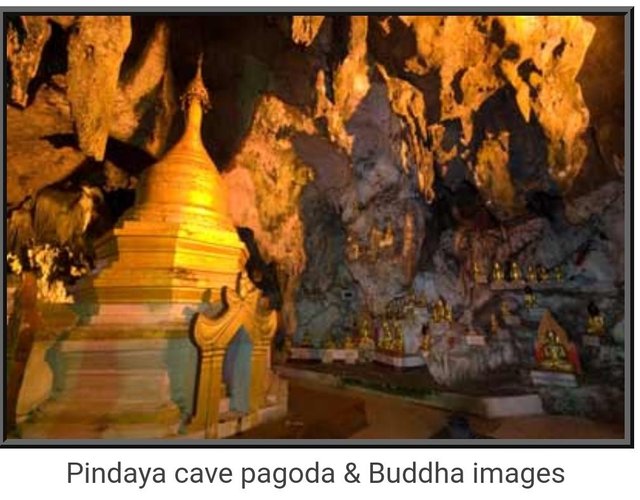Pindaya cave Cave cramped with thousands of Buddha images
Buddha images in the Pindaya cave
The Pindaya cave is an important pilgrimage site for Burmese Buddhists and an attractive, unusual sights for tourists.
The cave is set in a limestone hill in Central Burma not far from Inle Lake. The hill contains three caves, only one of which is open to the public. This cave that is about 150 meters long contains thousands of Buddha images in various styles and from different eras from the early Konbaung dynasty era to present day.
Every small corner and nook of the cave is cramped with Buddha images up to the ceiling. Between the images are also a number of small pagodas as well as stalagmites and stalactites.
During the course of several centuries thousands of Buddha images have been put inside the cave. Many statues bear the name of the person who donated it. The number of images is constantly growing since people are still adding more, by now there about 9,000.
Thousands of Buddha images cramped in the cave
It is not known with certainty when the first images were placed inside the cave, but the oldest ones bearing inscriptions date back to the Konbaung dynasty of the second half of the 18th century.
The Buddha images are in different styles, representing the various eras in which they were made. Many are gold plated, others are made from teak wood, marble, bronze or other material. Many are very small, some are life size.
Some smaller sections of the cave can only be entered by crawling in them. Some of these are used as meditation chambers that contain a smaller number of Buddha statues. Be careful when walking around in the dimly lit cave as the floor can get slippery. Handrails have been put up in parts of the cave, there are mats on the walkway.
During the festival held at the full moon day of Tabaung thousands of people come to the cave to pay homage. The small village of Pindaya on the lake is a serene and scenic place that has a number of restaurants and shops.
The Pagoda and prayer hall
At the entrance of the cave is the Shwe U Min Pagoda or the Golden Cave Pagoda. According to local legend this pagoda was built by King Ashoka, the Indian emperor who ruled much of present day India in the 3rd century BC.
Ashoka sent monks out across much of Asia to spread Buddhism and had numerous temples built including the famous Mahabodhi temple in India.
At the entrance of the cave is a large bronze bell cast in 1842. The prayer hall was built by a Burmese monk named U Khanti, who built many Buddhist structures across Burma including the Hintha Gon Paya in Mandalay and several structures on Mandalay Hill.
The legend of the spider
In front of the entrance is a sculpture of a giant spider and a Prince aiming his bow at it. Local legend tells that once a giant spider lived in the cave. One day the spider captured a local Princess and held her captive in the cave. According to the legend, the Prince armed with bow and arrow killed the spider, thus rescuing the Princess.
Pindaya cave pagoda & Buddha images
How to get to the Pindaya caves
The Pindaya cave is located in the Shan state in Central Burma near the village of Pindaya and not far from Heho airport and Inle Lake. It is about 1½ hours or more drive over a very scenic road in the hills from Heho airport, depending on road conditions and weather.
There is a long covered walkway from close to the town all the way of to the entrance of the cave. Alternatively, you can take a car or horse cart to the car park just below the entrance of the cave. A few steps up from the car park is an elevator leading to the caves entrance. Since the elevators walls are glass, you will have great views of Pindaya town and the lake on the way up. Instead of the elevator, you can also walk up the final part of the stairs. As the cave is a sacred place, please remove shoes and socks at the entrance.
Entrance fee & opening hours
The cave is open daily during daylight hours. Entrance fee is US$ 3 per person. 
